Differentiation of Types of Visual Agnosia Using EEG
Abstract
1. Introduction
1.1. Visuoperceptual Deficits and Electrophysiology
1.2. The Current Study
2. Materials and Methods
2.1. Participants
2.2. Design and Stimuli
2.3. EEG Recording
2.4. EEG Preprocessing
2.5. Frequency Domain Decoding
2.6. Time Course Decoding
2.7. Statistical Analysis
3. Results
3.1. Frequency Domain Decoding
3.2. Time Course Decoding
4. Discussion
4.1. Frequency Domain and Temporal Domain Decoding
4.2. Utility of EEG in the Study of Agnosia
4.3. Summary
Supplementary Materials
Author Contributions
Funding
Acknowledgments
Conflicts of Interest
References
- Humphreys, G.W.; Riddoch, M.J. Neuropsychological disorders of visual object recognition and naming. In Handbook of Neuropsychology (Vol. 4); Boller, F., Grafman, J., Eds.; Elsevier Science: North-Holland, The Netherlands, 2000. [Google Scholar]
- Behrmann, M.; Vida, M. Visual Object Recognition. In Stevens’ Handbook of Experimental Psychology and Cognitive Neuroscience; John Wiley & Sons: Hoboken, NJ, USA, 2018. [Google Scholar]
- Joy, P.; Brunsdon, R. Visual Agnosia and Prosopagnosia in Childhood: A Prospective Case Study. Child Neuropsychol. 2002, 8, 1–15. [Google Scholar] [CrossRef] [PubMed]
- Brooks, J.L.; Gilaie-Dotan, S.; Rees, G.; Bentin, S.; Driver, J. Preserved local but disrupted contextual figure-ground influences in an individual with abnormal function of intermediate visual areas. Neuropsychologia 2012, 50, 1393–1407. [Google Scholar] [CrossRef] [PubMed]
- Gilaie-Dotan, S.; Doron, R. Developmental visual perception deficits with no indications of prosopagnosia in a child with abnormal eye movements. Neuropsychologia 2017, 100, 64–78. [Google Scholar] [CrossRef] [PubMed]
- Farah, M.J. Visual Agnosia; MIT Press: Cambridge, MA, USA, 2004; ISBN 0262562030. [Google Scholar]
- Behrmann, M.; Nishimura, M. Agnosias. Wiley Interdiscip. Rev. Cogn. Sci. 2010, 1, 203–213. [Google Scholar] [CrossRef] [PubMed]
- Freud, E.; Ganel, T.; Shelef, I.; Hammer, M.D.; Avidan, G.; Behrmann, M. Three-Dimensional Representations of Objects in Dorsal Cortex are Dissociable from Those in Ventral Cortex. Cereb. Cortex 2017, 27, 422–434. [Google Scholar] [CrossRef] [PubMed]
- Riddoch, M.J.; Humphreys, G.W.; Akhtar, N.; Allen, H.; Bracewell, R.M.; Schofield, A.J. A tale of two agnosias: Distinctions between form and integrative agnosia. Cogn. Neuropsychol. 2008, 25, 56–92. [Google Scholar] [CrossRef] [PubMed]
- Behrmann, M.; Peterson, M.A.; Moscovitch, M.; Suzuki, S. Independent representation of parts and the relations between them: Evidence from integrative agnosia. J. Exp. Psychol. Hum. Percept. Perform. 2006, 32, 1169–1184. [Google Scholar] [CrossRef] [PubMed]
- Humphreys, G.W.; Riddoch, M.J. Features, objects, action: The cognitive neuropsychology of visual object processing, 1984–2004. Cogn. Neuropsychol. 2006, 23, 156–183. [Google Scholar] [CrossRef] [PubMed]
- Liu, T.T.; Nestor, A.; Vida, M.D.; Pyles, J.A.; Patterson, C.; Yang, Y.; Yang, F.N.; Freud, E.; Behrmann, M. Successful Reorganization of Category-Selective Visual Cortex following Occipito-temporal Lobectomy in Childhood. Cell Rep. 2018, 24, 1113–1122.e6. [Google Scholar] [CrossRef] [PubMed]
- Konen, C.S.; Behrmann, M.; Nishimura, M.; Kastner, S. The Functional Neuroanatomy of Object Agnosia: A Case Study. Neuron 2011, 71, 49–60. [Google Scholar] [CrossRef] [PubMed]
- Anaki, D.; Kaufman, Y.; Freedman, M.; Moscovitch, M. Associative (prosop)agnosia without (apparent) perceptual deficits: A case-study. Neuropsychologia 2007, 45, 1658–1671. [Google Scholar] [CrossRef] [PubMed]
- Ptak, R.; Lazeyras, F.; Di Pietro, M.; Schnider, A.; Simon, S.R. Visual object agnosia is associated with a breakdown of object-selective responses in the lateral occipital cortex. Neuropsychologia 2014, 60, 10–20. [Google Scholar] [CrossRef] [PubMed]
- Towler, J.; Eimer, M. Electrophysiological studies of face processing in developmental prosopagnosia: Neuropsychological and neurodevelopmental perspectives. Cogn. Neuropsychol. 2012, 29, 503–529. [Google Scholar] [CrossRef] [PubMed]
- Eimer, M.; Gosling, A.; Duchaine, B. Electrophysiological markers of covert face recognition in developmental prosopagnosia. Brain 2012, 135, 542–554. [Google Scholar] [CrossRef] [PubMed]
- Parketny, J.; Towler, J.; Eimer, M. The activation of visual face memory and explicit face recognition are delayed in developmental prosopagnosia. Neuropsychologia 2015, 75, 538–547. [Google Scholar] [CrossRef] [PubMed]
- Dalrymple, K.A.; Oruç, I.; Duchaine, B.; Pancaroglu, R.; Fox, C.J.; Iaria, G.; Handy, T.C.; Barton, J.J.S. The anatomic basis of the right face-selective N170 IN acquired prosopagnosia: A combined ERP/fMRI study. Neuropsychologia 2011, 49, 2553–2563. [Google Scholar] [CrossRef] [PubMed]
- Towler, J.; Gosling, A.; Duchaine, B.; Eimer, M. The face-sensitive N170 component in developmental prosopagnosia. Neuropsychologia 2012, 50, 3588–3599. [Google Scholar] [CrossRef] [PubMed]
- Prieto, E.A.; Caharel, S.; Henson, R.; Rossion, B. Early (N170/M170) Face-Sensitivity Despite Right Lateral Occipital Brain Damage in Acquired Prosopagnosia. Front. Hum. Neurosci. 2011, 5, 138. [Google Scholar] [CrossRef] [PubMed]
- Renault, B.; Signoret, J.-L.; Debruille, B.; Breton, F.; Bolgert, F. Brain potentials reveal covert facial recognition in prosopagnosia. Neuropsychologia 1989, 27, 905–912. [Google Scholar] [CrossRef]
- Small, M. Visual evoked potentials in a patient with prosopagnosia. Electroencephalogr. Clin. Neurophysiol. Evoked Potentials Sect. 1988, 71, 10–16. [Google Scholar] [CrossRef]
- Collins, E.; Dundas, E.; Gabay, Y.; Plaut, D.C.; Behrmann, M. Hemispheric organization in disorders of development. Vis. Cogn. 2017, 25, 416–429. [Google Scholar] [CrossRef] [PubMed]
- Fisher, K.; Towler, J.; Eimer, M. Reduced sensitivity to contrast signals from the eye region in developmental prosopagnosia. Cortex 2016, 81, 64–78. [Google Scholar] [CrossRef] [PubMed]
- Yamasaki, T.; Taniwaki, T.; Tobimatsu, S.; Arakawa, K.; Kuba, H.; Maeda, Y.; Kuwabara, Y.; Shida, K.; Ohyagi, Y.; Yamada, T.; et al. Electrophysiological correlates of associative visual agnosia lesioned in the ventral pathway. J. Neurol. Sci. 2004, 221, 53–60. [Google Scholar] [CrossRef] [PubMed]
- Gilaie-Dotan, S.; Perry, A.; Bonneh, Y.; Malach, R.; Bentin, S. Seeing with profoundly deactivated mid-level visual areas: Non-hierarchical functioning in the human visual cortex. Cereb. Cortex 2009, 19, 1687–1703. [Google Scholar] [CrossRef] [PubMed]
- Donchin, E.; Heffley, E.F. Maltivariate analysis of ERP data: A tutorial review. In Multidisciplinary Perspectives in Event-Related Brain Potential Research; EPA-600/9-77-043; Otto, D., Ed.; U.S. Government Printing Office: Washington, DC, USA, 1978; pp. 555–572. [Google Scholar]
- Düzel, E.; Habib, R.; Schott, B.; Schoenfeld, A.; Lobaugh, N.; McIntosh, A.R.; Scholz, M.; Heinze, H.J. A multivariate, spatiotemporal analysis of electromagnetic time-frequency data of recognition memory. Neuroimage 2003, 18, 185–197. [Google Scholar] [CrossRef]
- Robinson, A.K.; Venkatesh, P.; Boring, M.J.; Tarr, M.J.; Grover, P.; Behrmann, M. Very high density EEG elucidates spatiotemporal aspects of early visual processing. Sci. Rep. 2017, 7, 16248. [Google Scholar] [CrossRef] [PubMed]
- Rosenthal, O.; Behrmann, M. Acquiring long-term representations of visual classes following extensive extrastriate damage. Neuropsychologia 2006, 44, 799–815. [Google Scholar] [CrossRef] [PubMed]
- Gauthier, I.; Behrmann, M.; Tarr, M.J. Can Face Recognition Really be Dissociated from Object Recognition? J. Cogn. Neurosci. 1999, 11, 349–370. [Google Scholar] [CrossRef] [PubMed]
- Marotta, J.J.; Behrmann, M. Agnosia. In Encyclopedia of the Human Brain; Ramachandran, V.S., Ed.; Academic Press/Elsevier Science: San Diego, CA, USA, 2002; pp. 59–70. [Google Scholar]
- Behrmann, M.; Kimchi, R. What does visual agnosia tell us about perceptual organization and its relationship to object perception? J. Exp. Psychol. Hum. Percept. Perform. 2003, 29, 19–42. [Google Scholar] [CrossRef] [PubMed]
- Mapelli, D.; Behrmann, M. The role of color in object recognition: Evidence from visual agnosia. Neurocase 1997, 3, 237–247. [Google Scholar] [CrossRef]
- Marotta, J.J.; Behrmann, M.; Goodale, M.A. The removal of binocular cues disrupts the calibration of grasping in patients with visual form agnosia. Exp. Brain Res. 1997, 116, 113–121. [Google Scholar] [CrossRef] [PubMed]
- Vecera, S.P.; Behrmann, M. Spatial attention does not require preattentive grouping. Neuropsychology 1997, 11, 30–43. [Google Scholar] [CrossRef] [PubMed]
- Vecera, S.P.; Gilds, K.S. What Is It Like to Be a Patient with Apperceptive Agnosia? Conscious. Cogn. 1997, 6, 237–266. [Google Scholar] [CrossRef] [PubMed]
- Marotta, J.J.; Genovese, C.R.; Behrmann, M. A functional MRI study of face recognition in patients with prosopagnosia. Neuroreport 2001, 12, 1581–1587. [Google Scholar] [CrossRef] [PubMed]
- Delorme, A.; Makeig, S. EEGLAB: An open source toolbox for analysis of single-trial EEG dynamics including independent component analysis. J. Neurosci. Methods 2004, 134, 9–21. [Google Scholar] [CrossRef] [PubMed]
- Bigdely-Shamlo, N.; Mullen, T.; Kothe, C.; Su, K.; Robbins, K.A. The PREP pipeline: Standardized preprocessing for large-scale EEG analysis. Front. Neuroinform. 2015, 9. [Google Scholar] [CrossRef] [PubMed]
- Grootswagers, T.; Wardle, S.G.; Carlson, T.A. Decoding Dynamic Brain Patterns from Evoked Responses: A Tutorial on Multivariate Pattern Analysis Applied to Time Series Neuroimaging Data. J. Cogn. Neurosci. 2016, 29, 677–697. [Google Scholar] [CrossRef] [PubMed]
- Hebart, M.N.; Baker, C.I. Deconstructing multivariate decoding for the study of brain function. Neuroimage 2017. [Google Scholar] [CrossRef] [PubMed]
- Regan, D. Some characteristics of average steady-state and transient responses evoked by modulated light. Electroencephalogr. Clin. Neurophysiol. 1966, 20, 238–248. [Google Scholar] [CrossRef]
- Di Russo, F.; Pitzalis, S.; Aprile, T.; Spitoni, G.; Patria, F.; Stella, A.; Spinelli, D.; Hillyard, S.A. Spatiotemporal analysis of the cortical sources of the steady-state visual evoked potential. Hum. Brain Mapp. 2006, 28, 323–334. [Google Scholar] [CrossRef] [PubMed]
- Collins, E.; Robinson, A.K.; Behrmann, M. Distinct neural processes for the perception of familiar versus unfamiliar faces along the visual hierarchy revealed by EEG. Neuroimage 2018, 181, 120–131. [Google Scholar] [CrossRef] [PubMed]
- Riesenhuber, M.; Poggio, T. Hierarchical models of object recognition in cortex. Nat. Neurosci. 1999, 2, 1019–1025. [Google Scholar] [CrossRef] [PubMed]
- Akyürek, E.G.; Wolff, M.J. Extended temporal integration in rapid serial visual presentation: Attentional control at Lag 1 and beyond. Acta Psychol. 2016, 168, 50–64. [Google Scholar] [CrossRef] [PubMed]
- Hochstein, S.; Ahissar, M. View from the Top: Hierarchies and Reverse Hierarchies in the Visual System. Neuron 2002, 36, 791–804. [Google Scholar] [CrossRef]
- Behrmann, M.; Williams, P. Impairments in part–whole representations of objects in two cases of integrative visual agnosia. Cogn. Neuropsychol. 2007, 24, 701–730. [Google Scholar] [CrossRef] [PubMed]
- Humphreys, G.W. Integrative agnosia. In Case Studies in the Neuropsychology of Vision; Humphreys, G.W., Ed.; Psychology Press/Taylor & Francis: Hove, UK, 1999; pp. 41–58. [Google Scholar]
- Bentin, S.; DeGutis, J.M.; D’Esposito, M.; Robertson, L.C. Too Many Trees to See the Forest: Performance, Event-related Potential, and Functional Magnetic Resonance Imaging Manifestations of Integrative Congenital Prosopagnosia. J. Cogn. Neurosci. 2007, 19, 132–146. [Google Scholar] [CrossRef] [PubMed]
- Humphreys, G.W.; Riddoch, M.J. Routes to object constancy: Implications from neurological impairments of object constancy. Q. J. Exp. Psychol. Sect. A 1984, 36, 385–415. [Google Scholar] [CrossRef]
- Dmochowski, J.P.; Greaves, A.S.; Norcia, A.M. Maximally reliable spatial filtering of steady state visual evoked potentials. Neuroimage 2015, 109, 63–72. [Google Scholar] [CrossRef] [PubMed]
- Kaneshiro, B.; Perreau Guimaraes, M.; Kim, H.-S.; Norcia, A.M.; Suppes, P. A Representational Similarity Analysis of the Dynamics of Object Processing Using Single-Trial EEG Classification. PLoS ONE 2015, 10, e0135697. [Google Scholar] [CrossRef] [PubMed]
- Michel, C.M.; Murray, M.M. Towards the utilization of EEG as a brain imaging tool. Neuroimage 2012, 61, 371–385. [Google Scholar] [CrossRef] [PubMed]
- Murray, M.M.; Thelen, A.; Ionta, S.; Wallace, M.T. Contributions of Intraindividual and Interindividual Differences to Multisensory Processes. J. Cogn. Neurosci. 2018, 1–17. [Google Scholar] [CrossRef] [PubMed]
- Tzovara, A.; Murray, M.M.; Bourdaud, N.; Chavarriaga, R.; Millán, J.d.R.; De Lucia, M. The timing of exploratory decision-making revealed by single-trial topographic EEGanalyses. Neuroimage 2012, 60, 1959–1969. [Google Scholar] [CrossRef] [PubMed]
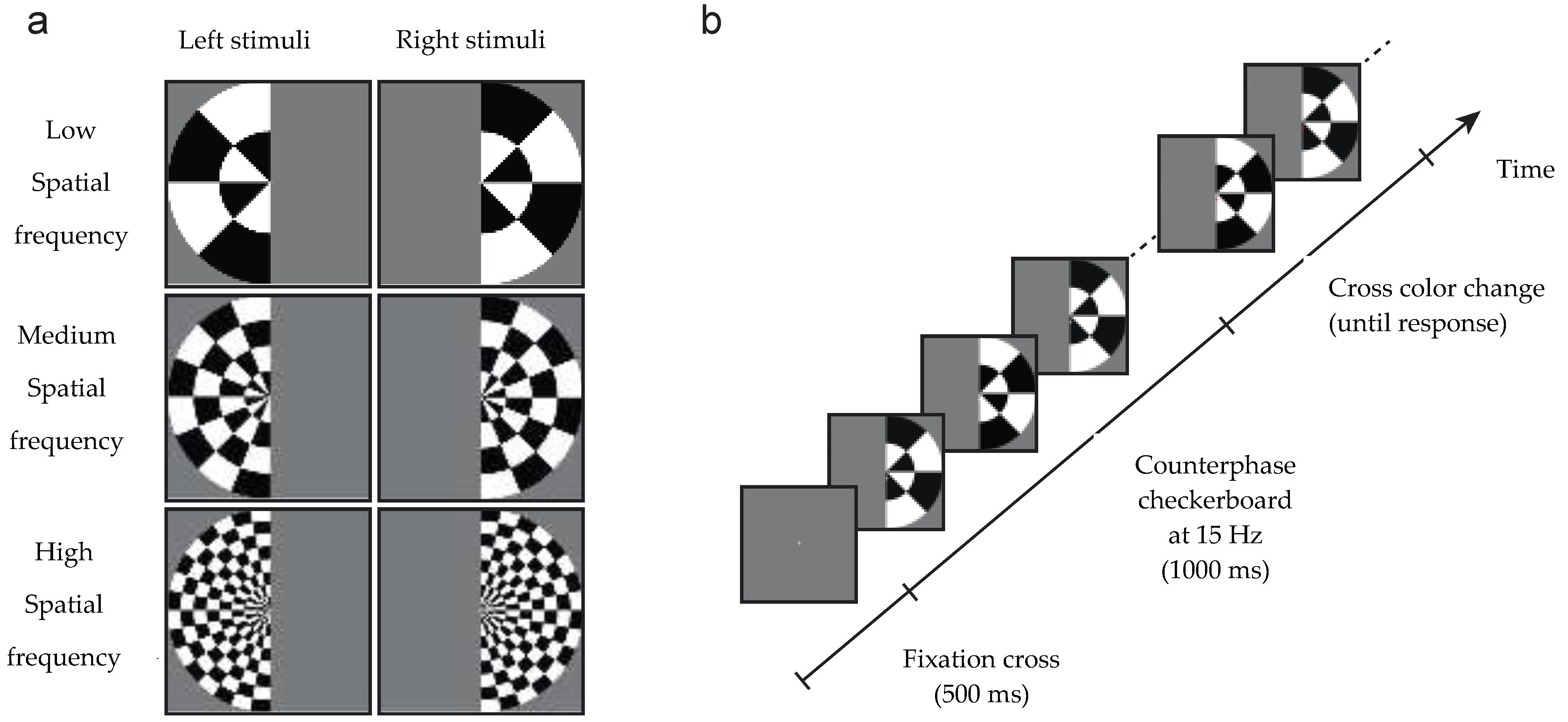
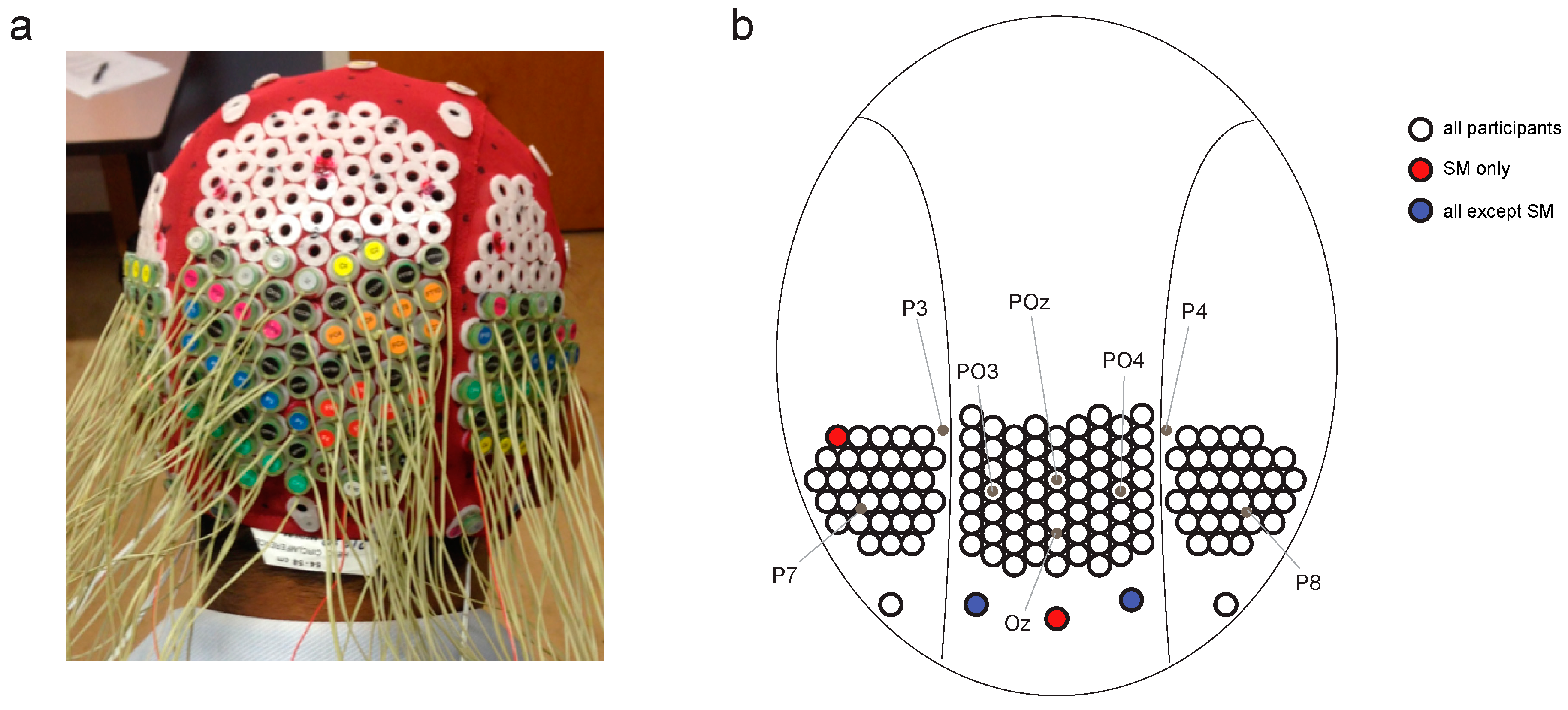
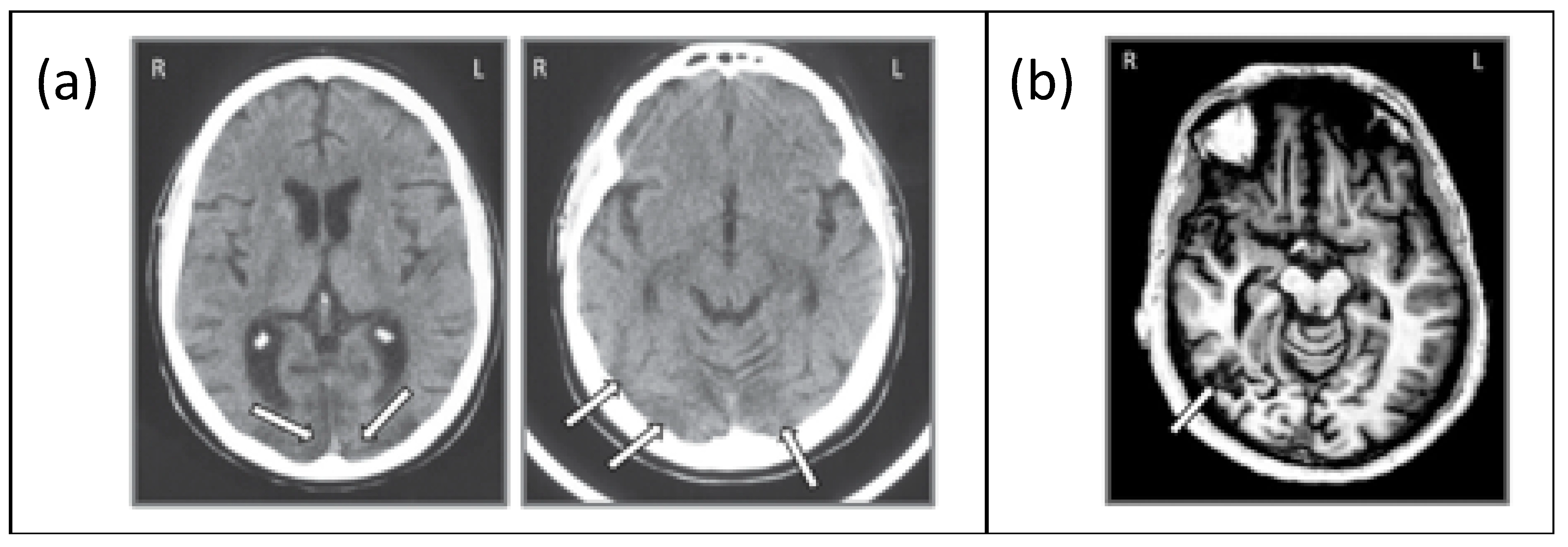
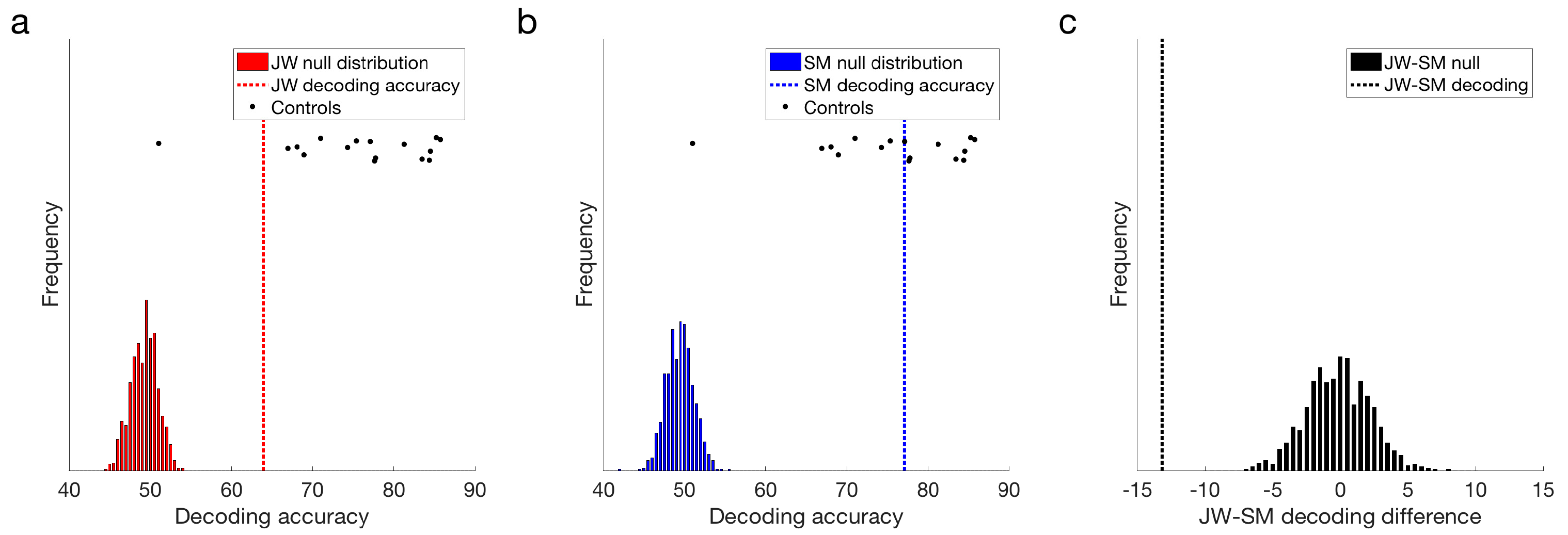
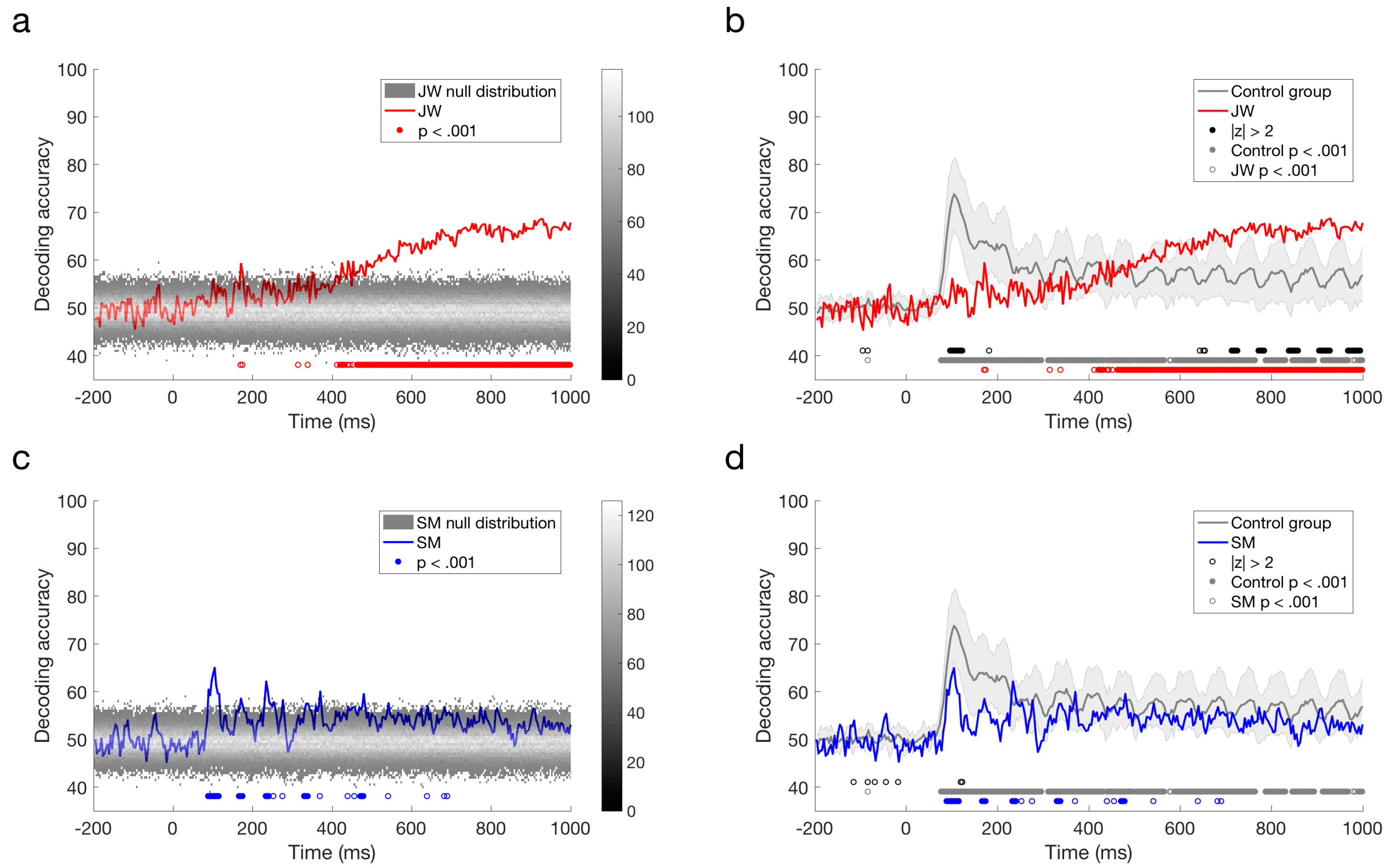
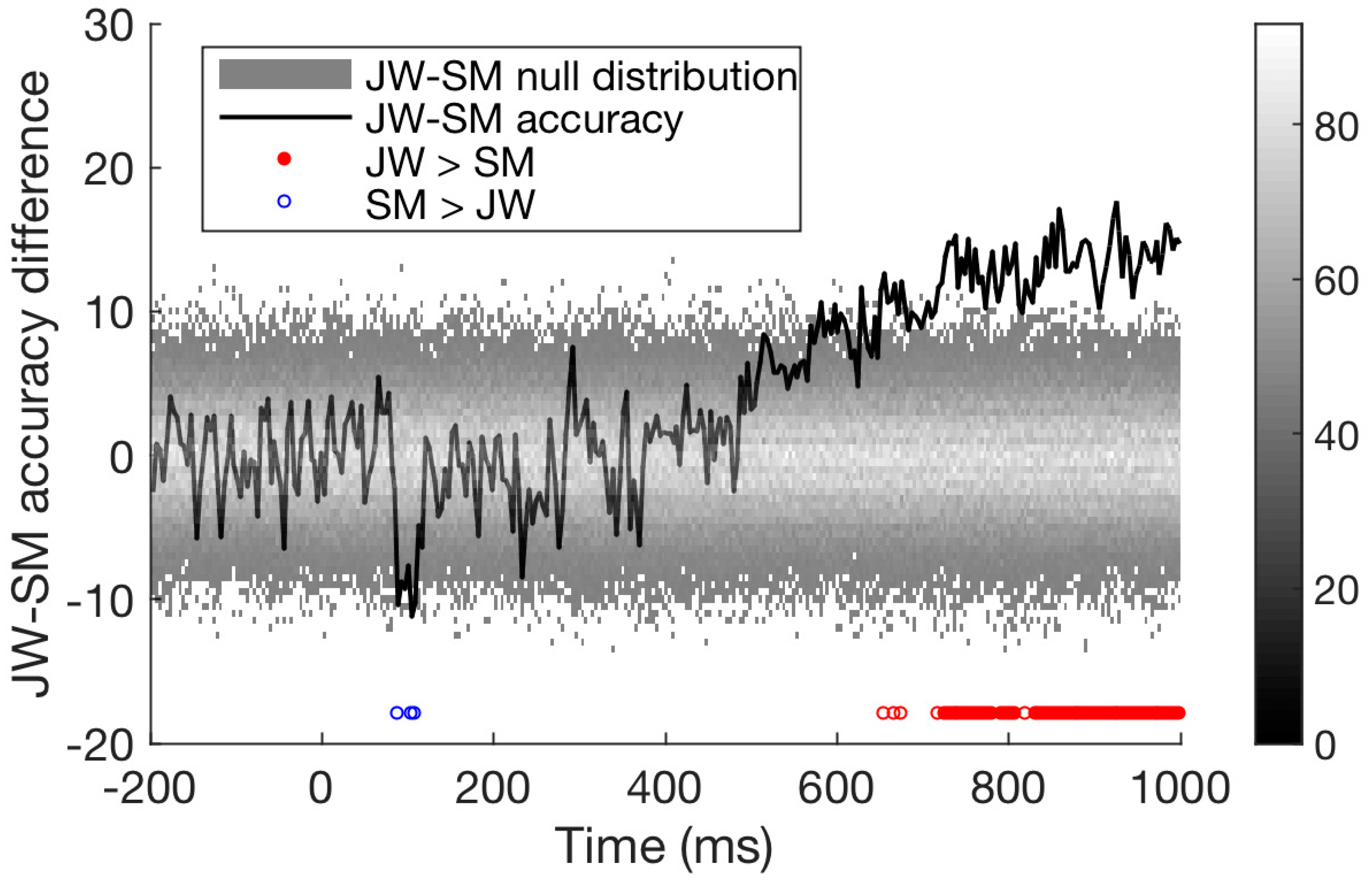
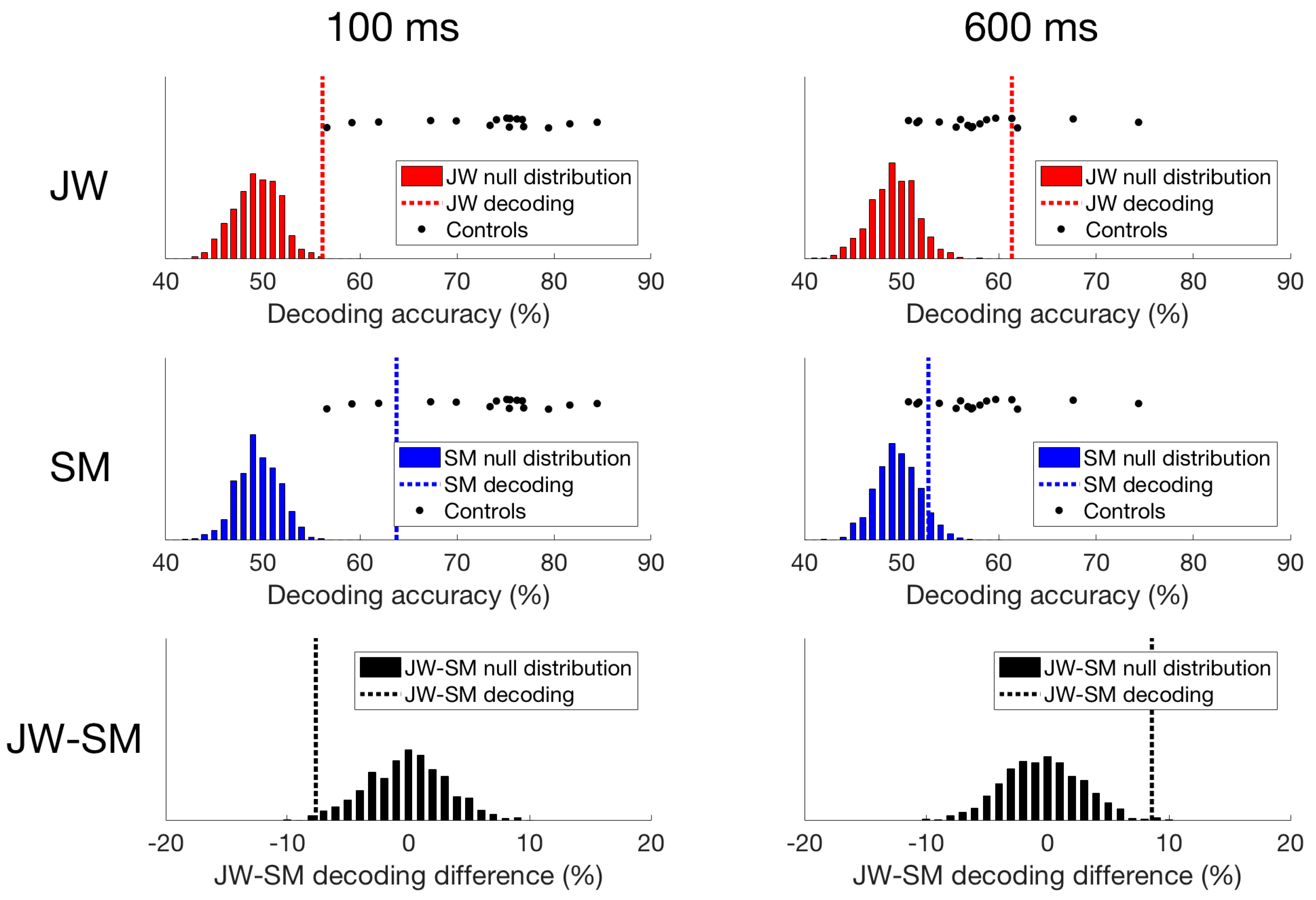
© 2018 by the authors. Licensee MDPI, Basel, Switzerland. This article is an open access article distributed under the terms and conditions of the Creative Commons Attribution (CC BY) license (http://creativecommons.org/licenses/by/4.0/).
Share and Cite
Haigh, S.M.; Robinson, A.K.; Grover, P.; Behrmann, M. Differentiation of Types of Visual Agnosia Using EEG. Vision 2018, 2, 44. https://doi.org/10.3390/vision2040044
Haigh SM, Robinson AK, Grover P, Behrmann M. Differentiation of Types of Visual Agnosia Using EEG. Vision. 2018; 2(4):44. https://doi.org/10.3390/vision2040044
Chicago/Turabian StyleHaigh, Sarah M., Amanda K. Robinson, Pulkit Grover, and Marlene Behrmann. 2018. "Differentiation of Types of Visual Agnosia Using EEG" Vision 2, no. 4: 44. https://doi.org/10.3390/vision2040044
APA StyleHaigh, S. M., Robinson, A. K., Grover, P., & Behrmann, M. (2018). Differentiation of Types of Visual Agnosia Using EEG. Vision, 2(4), 44. https://doi.org/10.3390/vision2040044




